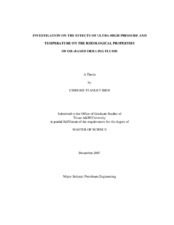| dc.description.abstract | Designing a fit-for-purpose drilling fluid for high-pressure, high-temperature (HP/HT)
operations is one of the greatest technological challenges facing the oil and gas industry
today. Typically, a drilling fluid is subjected to increasing temperature and pressure with
depth. While higher temperature decreases the drilling fluid’s viscosity due to thermal
expansion, increased pressure increases its viscosity by compression. Under these
extreme conditions, well control issues become more complicated and can easily be
masked by methane and hydrogen sulfide solubility in oil-base fluids frequently used in
HP/HT operations. Also current logging tools are at best not reliable since the
anticipated bottom-hole temperature is often well above their operating limit. The
Literature shows limited experimental data on drilling fluid properties beyond 350°F and
20,000 psig. The practice of extrapolation of fluid properties at some moderate level to
extreme-HP/HT (XHP/HT) conditions is obsolete and could result in significant
inaccuracies in hydraulics models.
This research is focused on developing a methodology for testing drilling fluids at
XHP/HT conditions using an automated viscometer. This state-of-the-art viscometer is
capable of accurately measuring drilling fluids properties up to 600°F and 40,000 psig. A
series of factorial experiments were performed on typical XHP/HT oil-based drilling
fluids to investigate their change in rheology at these extreme conditions (200 to 600°F and 15,000 to 40,000 psig). Detailed statistical analyses involving: analysis of variance,
hypothesis testing, evaluation of residuals and multiple linear regression are
implemented using data from the laboratory experiments.
I have developed the FluidStats program as an effective statistical tool for characterizing
drilling fluids at XHP/HT conditions using factorial experiments. Results from the
experiments show that different drilling fluids disintegrate at different temperatures
depending on their composition (i.e. weighting agent, additives, oil/water ratio etc). The
combined pressure-temperature effect on viscosity is complex. At high thresholds, the
temperature effect is observed to be more dominant while the pressure effect is more
pronounced at low temperatures.
This research is vital because statistics show that well control incident rates for non-
HP/HT wells range between 4% to 5% whereas for HP/HT wells, it is as high as 100%
to 200%. It is pertinent to note that over 50% of the world’s proven oil and gas reserves
lie below 14,000 ft subsea according to the Minerals Management Service (MMS). Thus
drilling in HP/HT environment is fast becoming a common place especially in the Gulf
of Mexico (GOM) where HP/HT resistant drilling fluids are increasingly being used to
ensure safe and successful operations. | en |


